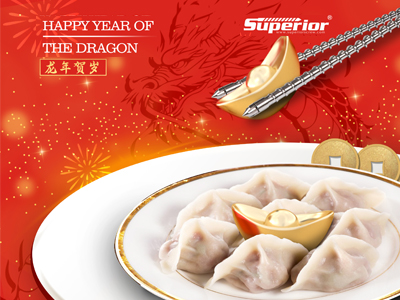
Good Luck in the Loong Year!
The dragon is a symbol of power, strength, and good luck in Chinese culture. May your family be blessed with happiness and harmony throughout the year. Happy Chinese New Year! from SUPERIOR team

The dragon is a symbol of power, strength, and good luck in Chinese culture. May your family be blessed with happiness and harmony throughout the year. Happy Chinese New Year! from SUPERIOR team

May the new year bring you peace, joy, and success in all your endeavors. Happy New Year 2025! –Ningbo Superior Machinery Team
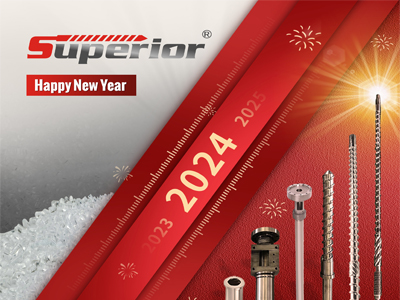
Time flies, we are stepping to usher in the New Year. Thank you for your trust throughout the year, we keep the commitment to support our clients with high-level and high-precision products to meet their needs in the coming year. Happy 2024!
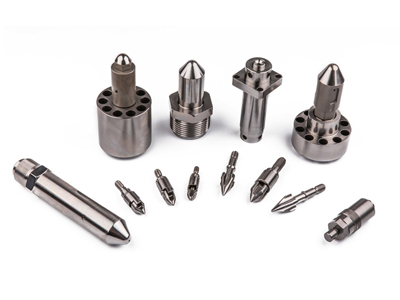
Principles of Selection of Plasticizing Barrel Assembly and Design of Injection Molding Nozzle Components Considerations: Conveying section, compression section, metering section, three-section ratio, compression ratio, depth of metering section screw groove, length-diameter ratio, number of teeth. Selection principles a.For good mixing effect, a design with a large length-diameter ratio, more teeth, high compression ratio, and shallow metering section screw groove should be used, such as PA, PE, PP, and POM. b.To prevent shear overheating, a design with a small length-diameter ratio, fewer teeth, long compression section, low compression ratio, and deeper metering section screw groove should be used, such as PC, PMMA, hard PVC, glass fiber reinforced or flame-retardant materials. c.For high plasticization rate, a design with a smaller compression ratio and deeper metering section screw groove should be used. Design of Injection Molding Nozzle Components A good check valve should have: a.Ability to stop quickly. b.Complete check function to maintain minimum plastic flow back. c.Smooth material flow without dead corners to avoid local shear heat, which can cause plastic degradation. d.Wear resistance and corrosion resistance. e.Ability to adapt to a variety of plastics.

Main factors affecting plasticizing quality The main factors affecting plasticizing quality are: length-to-diameter ratio, compression ratio, back pressure, screw speed, and barrel heating temperature, etc. Length-to-diameter ratio: the ratio of the effective working length of the screw to the diameter of the screw. a.A larger length-to-diameter ratio makes feeding more uniform; b.Plastics with better thermal stability can use longer screws to improve compounding without burning, while plastics with poor thermal stability can use shorter screws or screws without threads at the end. Considering the plastic characteristics, the length-to-diameter ratio is generally as follows: 14-16 for thermosetting plastics, 17-18 for rigid PVC, high viscosity PU and other thermosensitive plastics, 18-22 for general plastics, and 22-24 for high-temperature stable plastics such as PC and POM. Compression Ratio: the ratio of the last depth of the screw in the feeding section to the first depth of the screw in the metering section. a. Considering the compressibility of the material, filling degree, backflow and other factors, the product should be compact, with good heat transfer and ventilation. b. Appropriate compression ratio can increase the density of plastic, make the binding between molecules more tight, help reduce the absorption of air, lower the temperature rise caused by pressure, and affect the difference in output. Improper compression ratio will destroy the physical properties of plastic. c. The higher the compression ratio, the higher the temperature rise of the plastic during the plasticization process in the barrel, and the better the mixing uniformity of the plastic in

Several important geometric parameters of screws Screw diameter (D) a.Related to the required injection volume
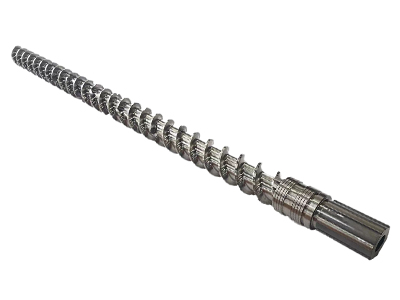
La parte principal del tornillo de pasador es un tornillo común, y el pasador de bloqueo se puede fijar en la ranura de la sección de fusión o sección de medición del tornillo, o en la superficie cilíndrica lisa al final de la sección de medición sin ranura de tornillo. Los pasadores de bloqueo están dispuestos de cierta manera con densidad y cantidad variables. Los pasadores de bloqueo cilíndricos se ensamblan en los orificios del tornillo, mientras que los pasadores de bloqueo cuadrados o en forma de diamante se fresan directamente sobre el tornillo. Si estos pasadores de bloqueo se colocan en la zona de fusión, pueden triturar la cama sólida, interrumpir el flujo de dos fases y mezclar las fases sólida y líquida, aumentando el área de contacto entre la fase sólida fragmentada y la materia fundida, promoviendo la fusión. Si los pasadores de bloqueo se colocan en la zona de transporte de fusión, su función principal es dividir el flujo de material, aumentar la interfaz, cambiar la dirección del flujo de material y reorganizar el haz de flujo. Al dividir y fusionar repetidamente y cambiar la dirección del flujo, se pueden homogeneizar los componentes y la temperatura del material fundido.La sección de mezcla es una estructura ranurada que se abre hacia adentro, colocada en el extremo de la sección de homogeneización de tornillo común, y su diámetro exterior es igual al diámetro exterior del tornillo. Las ranuras se dividen en varias grupos y la zona de convergencia del

The 35th International Plastics and Rubber Industry Exhibition will be held in Shenzhen, China from April 17th to April 20th. Superior Machinery will participate in this exhibition. Booth No.: 9Y59 (Hall 9) We look forward to meeting you there. ——Ningbo Superior Machinery Team
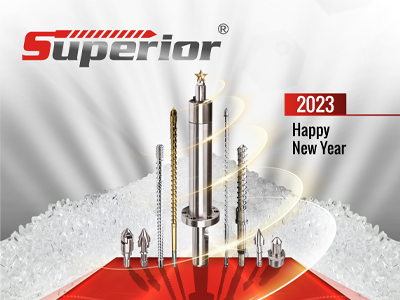
Dear Customers, Thank you for your cooperation and support in 2022. SUPERIOR will continue to provide you with superior quality products and services. Thank you again!Looking forward to our close cooperation in the future. Ningbo Superior Machinery Team
No.9 Jixiang Rd, Xihou Industrial, Jintang Town, Dinghai District, Zhoushan City, 316031 Zhejiang Province, China.
Tel: +86-574-89075950
E-mail: info@superior-machinery.com
Copyright © 2021 SUPERIOR MACHINERY CO.,LTD Todos los derechos reservados
